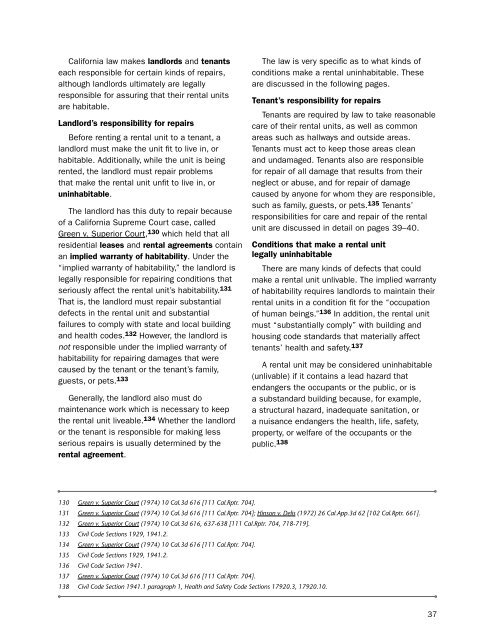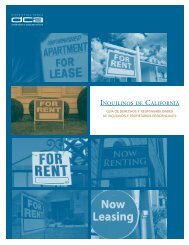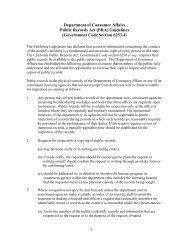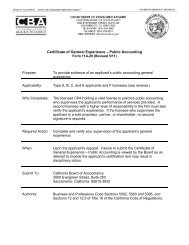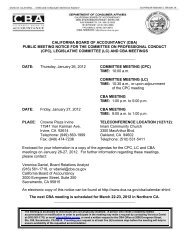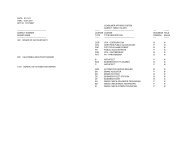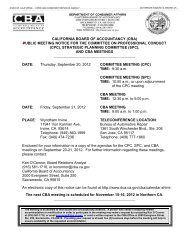California Tenants - Department of Consumer Affairs - State of ...
California Tenants - Department of Consumer Affairs - State of ...
California Tenants - Department of Consumer Affairs - State of ...
You also want an ePaper? Increase the reach of your titles
YUMPU automatically turns print PDFs into web optimized ePapers that Google loves.
<strong>California</strong> law makes landlords and tenants<br />
each responsible for certain kinds <strong>of</strong> repairs,<br />
although landlords ultimately are legally<br />
responsible for assuring that their rental units<br />
are habitable.<br />
landlord’s responsibility for repairs<br />
before renting a rental unit to a tenant, a<br />
landlord must make the unit fit to live in, or<br />
habitable. Additionally, while the unit is being<br />
rented, the landlord must repair problems<br />
that make the rental unit unfit to live in, or<br />
uninhabitable.<br />
the landlord has this duty to repair because<br />
<strong>of</strong> a <strong>California</strong> supreme Court case, called<br />
Green v. superior Court, 130 which held that all<br />
residential leases and rental agreements contain<br />
an implied warranty <strong>of</strong> habitability. under the<br />
“implied warranty <strong>of</strong> habitability,” the landlord is<br />
legally responsible for repairing conditions that<br />
seriously affect the rental unit’s habitability. 131<br />
that is, the landlord must repair substantial<br />
defects in the rental unit and substantial<br />
failures to comply with state and local building<br />
and health codes. 132 however, the landlord is<br />
not responsible under the implied warranty <strong>of</strong><br />
habitability for repairing damages that were<br />
caused by the tenant or the tenant’s family,<br />
guests, or pets. 133<br />
Generally, the landlord also must do<br />
maintenance work which is necessary to keep<br />
the rental unit liveable. 134 Whether the landlord<br />
or the tenant is responsible for making less<br />
serious repairs is usually determined by the<br />
rental agreement.<br />
the law is very specific as to what kinds <strong>of</strong><br />
conditions make a rental uninhabitable. these<br />
are discussed in the following pages.<br />
tenant’s responsibility for repairs<br />
tenants are required by law to take reasonable<br />
care <strong>of</strong> their rental units, as well as common<br />
areas such as hallways and outside areas.<br />
tenants must act to keep those areas clean<br />
and undamaged. tenants also are responsible<br />
for repair <strong>of</strong> all damage that results from their<br />
neglect or abuse, and for repair <strong>of</strong> damage<br />
caused by anyone for whom they are responsible,<br />
such as family, guests, or pets. 135 tenants’<br />
responsibilities for care and repair <strong>of</strong> the rental<br />
unit are discussed in detail on pages 39–40.<br />
conditions that make a rental unit<br />
legally uninhabitable<br />
there are many kinds <strong>of</strong> defects that could<br />
make a rental unit unlivable. the implied warranty<br />
<strong>of</strong> habitability requires landlords to maintain their<br />
rental units in a condition fit for the “occupation<br />
<strong>of</strong> human beings.” 136 in addition, the rental unit<br />
must “substantially comply” with building and<br />
housing code standards that materially affect<br />
tenants’ health and safety. 137<br />
A rental unit may be considered uninhabitable<br />
(unlivable) if it contains a lead hazard that<br />
endangers the occupants or the public, or is<br />
a substandard building because, for example,<br />
a structural hazard, inadequate sanitation, or<br />
a nuisance endangers the health, life, safety,<br />
property, or welfare <strong>of</strong> the occupants or the<br />
public. 138<br />
130 Green v. Superior Court (1974) 10 Cal.3d 616 [111 Cal.Rptr. 704].<br />
131 Green v. Superior Court (1974) 10 Cal.3d 616 [111 Cal.Rptr. 704]; Hinson v. Delis (1972) 26 Cal.App.3d 62 [102 Cal.Rptr. 661].<br />
132 Green v. Superior Court (1974) 10 Cal.3d 616, 637-638 [111 Cal.Rptr. 704, 718-719].<br />
133 Civil Code Sections 1929, 1941.2.<br />
134 Green v. Superior Court (1974) 10 Cal.3d 616 [111 Cal.Rptr. 704].<br />
135 Civil Code Sections 1929, 1941.2.<br />
136 Civil Code Section 1941.<br />
137 Green v. Superior Court (1974) 10 Cal.3d 616 [111 Cal.Rptr. 704].<br />
138 Civil Code Section 1941.1 paragraph 1, Health and Safety Code Sections 17920.3, 17920.10.<br />
37


